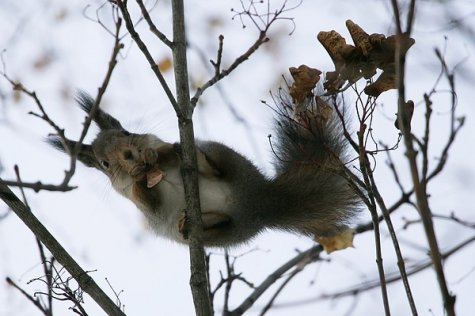Seasonal fur fashion
Photo:Arne Ader, www.loodusemees.ee
Translation:SilverT
Squirrel eating a maple seed
Eurasian red squirrel; red squirrel
Harilik orav ehk orav Sciurus vulgaris
The diurnal squirrels have plenty to do almost the entire time there is light outside with this nice autumn weather. When the weather is poor, rainy, let alone stormy, these little animals can rarely be seen outside as they are spending the time in the nest. The animals are now wearing a new thick greyish undercoat which is clearly visible. The „brushes“ on ears are long and sensitive and the so-called touching-hairs grow on the front paws, the stomach and also the tail. Large adult squirrels can weigh almost four hundred grams, summer-born young-ones are half the weight.
Deciduous trees in parks have tree hollows or woodpecker holes which the squirrels can successfully use, as well as the bird houses built by people. These are sometimes used for shelter, but more often as a storage for winter stocks to keep the collected seeds, acorns, nuts... This year was not a good year for mushrooms and these haven`t been seen hung to dry on shrubs and trees. Stocks for the winter are also being hidden in the moss or soil near the trees but it must be said that the squirrels do not have a very good memory. They go to feast on sunflower seeds in the feeding spots of winter birds and in parks they are asking the walkers for an „impost“ – the squirrels are used to people there.
The squirrels that live in forests build their nests by themselves and let`s perhaps talk about this another time, when there will be proper imagery.
Squirrels have been keeping a close eye on their territory ever since the autumn when winter stocks were collected and other members of the species will not be tolerated there even during years when there is an abundance of cones, when the firs are covered with cones, like last year.
The seeds of fir cones are the favourite food of forest squirrels, but the seeds of pine cones are almost equally appreciated, but in this case squirrels also have to relocate to pine forests. There aren`t many fir cones this year and while the situation is a bit better with pine cones, the number of competitors has also grown.









